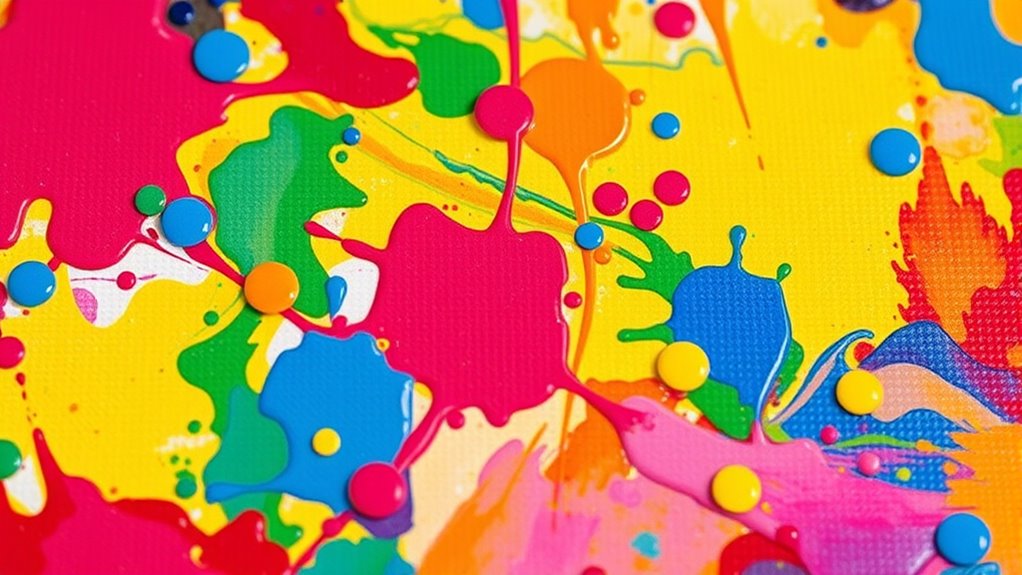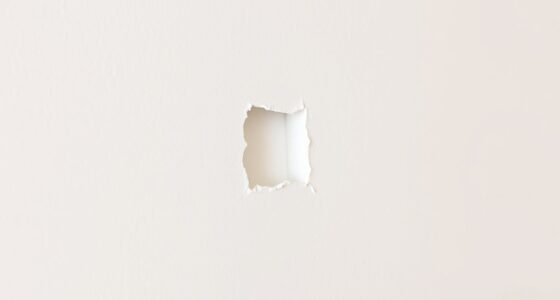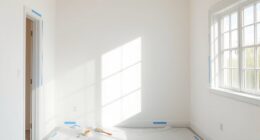To achieve a paint finish without brush strokes, try the sock method. Wrap a lint-free sock or cloth around a roller or sponge, then evenly load it with paint. This creates a soft, smooth applicator that glides over your surface, reducing streaks and marks. Use gentle, overlapping strokes and maintain consistent pressure for the best results. Keep practicing, and you’ll discover more tips to perfect your flawless finish.
Key Takeaways
- The sock method uses a lint-free sock or cloth over a roller to evenly distribute paint, preventing brush marks and streaks.
- Prepare surfaces thoroughly and load the roller lightly before wrapping it with a clean sock for smooth application.
- Use gentle, overlapping strokes with the sock-covered roller to achieve a seamless, streak-free finish.
- Combine the sock technique with high-quality rollers or foam brushes for optimal, professional results.
- Allow proper drying between coats and maintain consistent technique to ensure a flawless, brush-stroke-free surface.

If you want a smooth, flawless finish without visible brush strokes, modern painting techniques and tools can help you achieve that goal. One effective method gaining popularity is the sock technique, which offers a seamless, streak-free look. Before diving into the process, understanding brush stroke techniques and roller painting tips will maximize your results. Traditional brushes often leave marks or uneven texture, but by adopting alternative tools, you can create a professional finish with less effort.
Achieve a flawless finish with modern techniques like the sock method for streak-free walls.
The sock method involves using a clean, lint-free sock or cloth over a roller or paint sponge. This technique allows you to distribute paint evenly across the surface, minimizing brush marks and streaks. Start by preparing your surface thoroughly, ensuring it’s smooth and free of dust. When applying paint, load your roller or sponge lightly, then wrap it with the sock or cloth, securing it tightly. This creates a soft, even applicator that glides smoothly over walls or ceilings.
As you paint, employ gentle, overlapping strokes to maintain consistent coverage. The sock acts as a buffer, reducing the chance of uneven paint distribution, which is a common issue with brush stroke techniques. Keep your strokes uniform in direction and avoid pressing too hard, as this can create unwanted textures or streaks. If you notice any inconsistencies, switch to a clean sock or re-saturate it with paint for a fresh application. Using a sock in this way helps you avoid the typical pitfalls of brush strokes, like visible lines or uneven patches. Additionally, maintaining proper layering techniques and allowing sufficient drying time between coats will further enhance your finish.
In terms of roller painting tips, opt for high-quality rollers with a short nap for smoother finishes. Foam rollers are also excellent for achieving a sleek surface. When combined with the sock technique, these tools enhance your ability to apply paint uniformly. Always work in small sections, maintaining a wet edge to prevent lap marks. Light pressure is key—pressing too hard can cause uneven paint layers and streaks, defeating the purpose of the sock method. Additionally, consider slicing in the edges with a brush or small roller before using the sock to ensure clean lines, especially along corners and trims.
Frequently Asked Questions
Can the Sock Method Be Used on Textured Surfaces Effectively?
Yes, you can use the sock method on textured surfaces effectively. Before you start, guarantee proper surface preparation to smooth out rough areas and improve paint adhesion. The sock method works well because it allows you to evenly distribute paint over uneven textures, reducing brush strokes or roller marks. Just be patient, apply multiple coats if needed, and make sure the surface is clean and dry for the best results.
What Types of Paint Work Best With the Sock Technique?
Imagine your project as a canvas waiting for a smooth, even coat. You’ll find that latex paint works best with the sock technique because it spreads easily and dries quickly, creating a soft, matte finish. Oil-based paints can also work, but they require more patience and care. Ultimately, latex is your best bet for achieving a flawless, brush-stroke-free look using this method.
Is Special Equipment Needed to Achieve the Sock Painting Effect?
You don’t need special equipment to achieve the sock painting effect, but proper surface preparation is essential. Make sure the surface is smooth, clean, and dry before you start. The sock acts as your applicator, so just use a clean, soft sock or a similar fabric. No brushes or rollers are necessary, making this method simple and accessible. With the right surface prep, you’ll get smooth, brush-stroke-free results effortlessly.
How Long Does the Sock Method Take Compared to Traditional Painting?
Think of the sock method as a swift breeze compared to a slow-moving river. You’ll find it saves you time, making your project much more time-efficient. While traditional painting can take hours or even days, the sock technique usually shortens your project duration considerably. You’ll finish faster without sacrificing quality, giving you more time to enjoy your artwork or move on to the next creative adventure.
Are There Any Surfaces or Projects Unsuitable for This Technique?
You should avoid using the sock method on fragile materials or surfaces needing high precision details. The technique’s uneven application could damage delicate items or obscure fine craftsmanship. It’s best suited for rough or sturdy surfaces, where the textured, quick-drying paint can be applied evenly without risking damage. For intricate or fragile projects, traditional methods might be safer to guarantee the best outcome and preserve the integrity of your work.
Conclusion
Now that you’ve revealed the sock method, your paintbrushes can rest. Imagine your strokes flowing like a gentle river, smooth and seamless, painting a landscape without a single brushstroke betraying your hand. This technique transforms your canvas into a whispering breeze, soft and effortless. With each sock glide, you craft art that feels like a dream—fluid, natural, and alive—proving that sometimes, the simplest tools create the most breathtaking masterpieces.









